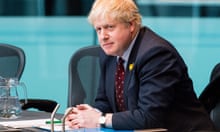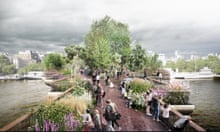London’s planned garden bridge could end up reliant on public money to cover running costs once built because its proposed business plan is wildly optimistic and riddled with untested assumptions, according to an expert report on the project.
Dan Anderson, who runs a consultancy that advises tourist attractions and similar destinations, said the business plan for the proposed 367-metre link across the Thames was possibly the least robust he had seen in 20 years in the industry.
“I’ve never seen one that is so obviously weak,” said Anderson, of the Fourth Street consultancy. Most such projects normally needed lottery funding and thus had their business plans scrutinised, he said. “This one just seems to have sailed through with very little challenge.”
The Thomas Heatherwick-designed structure, to run between Temple on the north side of the river and the South Bank, is forecast to cost £175m. Of this, £60m will come from public money – half from the Department for Transport and half from Transport for London.
The project received heavy backing from Boris Johnson as London mayor, but his Labour successor, Sadiq Khan, has since pledged that no more public money will go to the bridge and last week halted some existing spending ahead of a review.
But Anderson, a critic of the bridge who undertook the 44-page report without being commissioned, said Khan’s pledge was likely to be unrealistic.
Anderson’s analysis of the business plan produced in March by the Garden Bridge Trust calculates that although the trust predicts a £232,000 net profit in the first year of operation, a more realistic outcome is a £165,000 loss. A more gloomy set of assumptions brings a projected loss for the year of nearly £1m. A predicted near-£500,000 profit in year five is more likely to be a small loss, the report says.
Anderson argues that much of the trust’s projected income from donations is based on models taken from museums and galleries, whereas the bridge is billed as primarily a transport link for pedestrians – 65% of users are forecast to be regular commuters unlikely to use voluntary contactless donation points. “Simply making this key adjustment reduces projected income by some £200,000 per annum,” Anderson writes.
Similarly, he argues that projections for fundraising and sponsorship include “virtually no explanation of what the Garden Bridge Trust will do to raise these funds”. Museums and palaces can offer donors discounted admission, or entry to areas otherwise closed to the public, but the garden bridge will be open to the public and thus has little scope for offering extras.
As an example of the seemingly fuzzy approach to finance, Anderson notes that income from contactless donations was initially overestimated by £175,000 because the wrong projection for visitor numbers was used.
The mistake was corrected in a later version of the business plan, but the shortfall was simply made up by increasing projected sponsorship income, something Anderson called “typical of a target-driven business plan that is insufficiently supported by relevant research”.
The report notes that the business plan also fails to consider costs from £20m of the TfL money, which has been turned into a long-term loan. Although the loan is exempt from interest for five years, it does feature an inflation index of up to 2% a year, which is not fully accounted for.
The business plan was so flawed, Anderson told the Guardian, that he assumed the trust was largely working on the assumption that it would be bailed out by the taxpayer if needed. So keen was the trust to get the bridge built, he said, that it had abandoned possible funding methods in order to placate critics – for example, by giving away commercial revenues from the south landing of the bridge to the housing trust that has the lease on the relevant land.
“At every stage they took the path of least resistance, and the consequence was they made a sequence of decisions that effectively gave away all of the downstream commercial potential,” Anderson said. “It just feels like they’re not interested in the operational viability. It’s very short-term. The primary objective is get it built, and the future will sort itself out.”
A spokeswoman for the Garden Bridge Trust said that the organisation believed it had a “clear and robust business plan”, adding that the March version was a draft that would be revised, partly because Khan reduced the number of days per year the bridge could be closed for corporate events.
“The revised plan will be subject to scrutiny by Lambeth and Westminster councils and the mayor’s office,” she said. “The report forms part of the planning conditions requiring approval before construction can start.
“The trust fundamentally believes that the garden bridge is for Londoners and for everyone, and therefore it would not be right to charge people to cross the bridge.”









